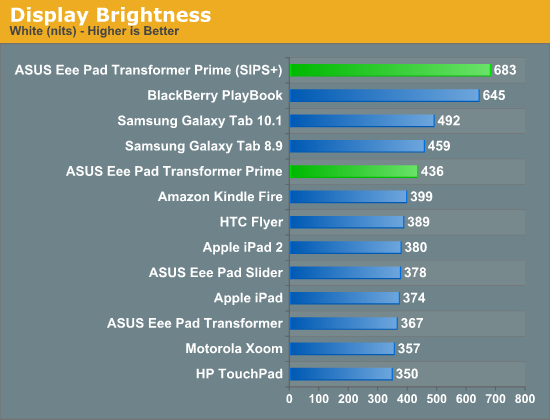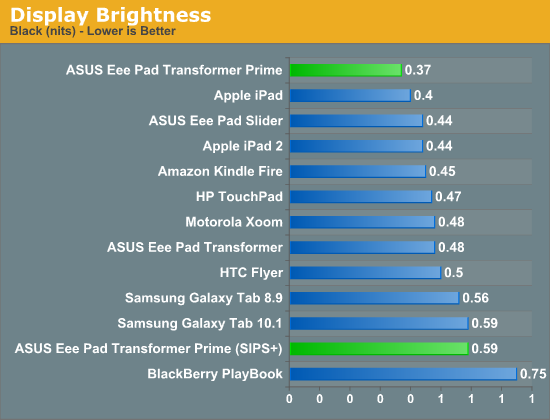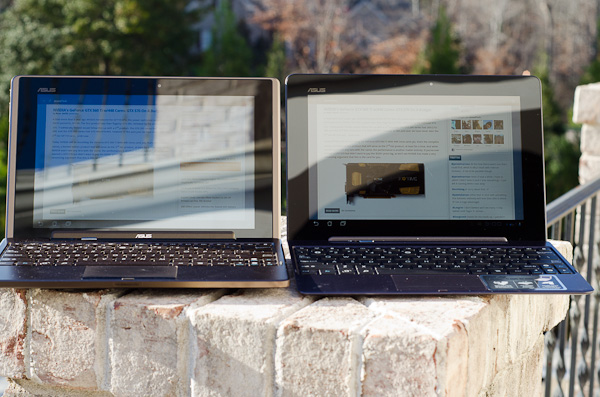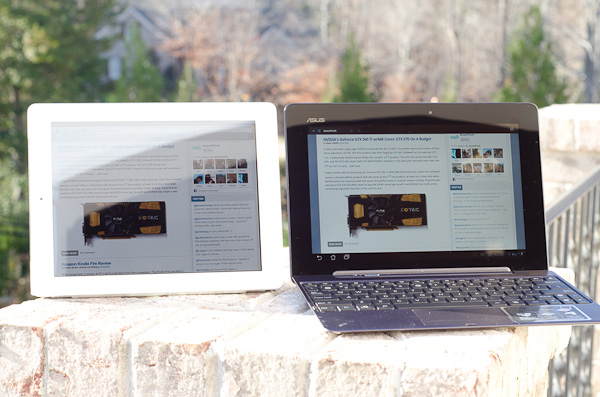ASUS Eee Pad Transformer Prime & NVIDIA Tegra 3 Review
by Anand Lal Shimpi on December 1, 2011 1:00 AM ESTThe Display: Perfect
The original Transformer had a display that performed similarly to the iPad, but was far more reflective thanks to a fairly large gap between the outer glass and the LCD panel underneath. I excused the first generation Eee Pad in the display department because it was good enough and $100 cheaper than the competing Apple solution. The Prime reaches price parity with the iPad 2, and as a result it must meet a higher standard. ASUS doesn't disappoint - the Eee Pad Transformer Prime has the best display I've seen on a tablet to date.
The resolution is a Honeycomb-standard 1280 x 800. The 16:10 panel measures 10.1-inches diagonally, giving it a very similar surface area to the iPad 2's 9.7-inch 4:3 display. The increase in resolution more than makes up for the larger screen however, ASUS delivers 145 pixels per inch compared to the iPad 2's now quite-dated ~132 PPI.
It's not all about pixel density here, the Transformer Prime has better white and black levels than anything else in its class. It also sets the new benchmark for contrast ratio at nearly 1200:1. The huge gap between the outermost glass and the IPS LCD panel has been reduced significantly, in turn reducing glare.



ASUS also has a Super IPS+ mode that drives the display to a class-leading 683 nits. The Super IPS+ mode obviously draws more power but ASUS recommends it if you're trying to use your tablet outdoors. In our review of the PlayBook we found that 600 nits was really the cutoff for usability in sunny conditions, and ASUS easily exceeds that. It's also worth pointing out that while Super IPS+ increases black levels as well, the resulting contrast ratio remains the same.

Original TF (left) vs. Super IPS+ enabled on the TF Prime (right)

iPad 2 (left) vs. Super IPS+ enabled on the TF Prime (right)
Viewing angles are absolutely awesome. Yes this is the same ASUS that let us down with the UX panels but it definitely got the panel right when it came to the Transformer Prime. Fingerprints are still going to be evident on the display but they don't seem to be as bad as on the original Transformer, and they do wipe off easily. This time around ASUS bundles a microfiber cloth to aid in keeping your Transformer looking fresh.
ASUS, Apple and the rest of the tablet world are in hot pursuit of even higher resolution panels, the problem is yields on these small 1080p and 2048x1536 panels just aren't high enough yet. The Android crowd will have to wait, although Apple is apparently pushing very hard (and trying to buy up a lot of inventory) to deliver a "retina display" equipped iPad 2+/3 by Q2 next year. I'm hearing Q3/Q4 for everyone else and it's still not a guarantee that Apple will be able to meet its aggressive targets either at this point.










204 Comments
View All Comments
Anand Lal Shimpi - Thursday, December 1, 2011 - link
Thank you, I appreciate the kind words :)Take care,
Anand
cotak - Thursday, December 1, 2011 - link
Everyone seems so impressed but for me the big elephant is why is the GPU slower than the ipad2's from a GPU company? And to boot the CPU performance isn't significantly faster either? What's going on?Death666Angel - Thursday, December 1, 2011 - link
CPU is pretty fast when you look at multi-core enabled Linpack. Other programs probably don't handle the 4 cores very efficiently.As for the GPU, Apple has been very aggressive in marketing iOS (specifically the iPads) as mobile consoles, so they really delivered in the GPU department. The downside of that is that the die size of the A5 is 122mm² according to Anand (4s review), whereas Tegra3 even with 5 CPU cores only has 80mm² (Tegra3 launched article). :-)
thunng8 - Thursday, December 1, 2011 - link
Not sure if they are equivalent tests, but in the ipad2 review, ipad2 scored 170.9 MFLOP which is higher than the Transformer Prime's score of 135.9.I don't think the average consumer cares about how big the die size is, they will however notice the extra GPU performance.
Also, even with the bigger dies size, it doesn't seem to affected battery life either.
Blaster1618 - Thursday, December 1, 2011 - link
GPU:Power VR SGX 543MP2 (iPAD 2) 60 nm
8 Pixel processor * maximum 4 separate address per vector per cycle= 32 addresses per cycle.
Tegra 3 40 nm
12 Pixel processors x 1 separate address per vector=12 addresses per cycle.
Isn't there a secret slot where you can slip in a NV104 processor and give this story a happy ending. Last time I bought an apple was a Apple IIc. (google it), but in this case power's simultaneous multi-threading beats the brawn of 12 processors. (darn). maybe wayne will get smart and 28nm.
vision33r - Thursday, December 1, 2011 - link
There's nothing to be impressed with. It's another poor attempt by Nvidia to rush a product out the door and getting their ass handed by the iPad2's higher optimized design.How embarrassing to let a 1GHZ dualcore SOC spank a 1.4GHZ quadcore Tegra 3.
I don't know people are excited especially that from what we know of the upcoming Apple's A6 designs and iPad 3 will make this thing forgotten very soon.
GmanMD - Thursday, December 1, 2011 - link
Any idea as to whether you would be able to hook up a 4g wireless usb modem to the dock on this? It would be awesome to have that flexibility.medi01 - Thursday, December 1, 2011 - link
I hope one day Anand would stop judging screens only on min/max brightness and would do a proper test, that would also compare gamut.Anand Lal Shimpi - Thursday, December 1, 2011 - link
That day will come very soon... ;)Take care,
Anand
Toadster - Thursday, December 1, 2011 - link
how do the these stack up against each other?